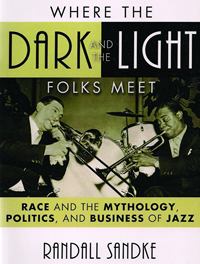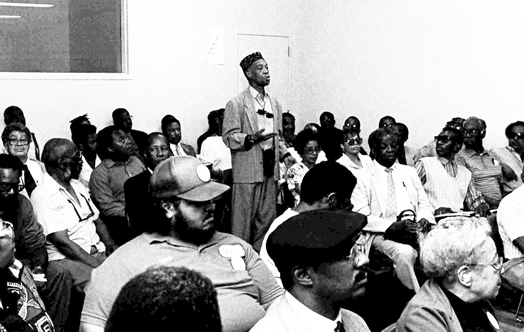Allegro
Black and White Together
Local 802's archives show that we were an early and significant force in the struggle to achieve racial equality
Volume 123, No. 2February, 2023

PLAYING TOGETHER: Local 802 member Randy Sandke’s book uses the union’s archives to show that Local 802’s racial history was more progressive than most. Pictured on the book cover are Louis Armstrong and Jack Teagarden.
In the course of researching my book “Where the Light and the Dark Folks Meet,” which deals with interracial contact in jazz, I went through the earliest surviving copies of Allegro to see what they might show about the union’s dealings with African-American musicians. Local 802 was unusual in that it was always open to both black and white musicians. (Detroit was the only other local of the AFM that drew no color line.)
But admitting blacks and being responsive to their needs can be two different things. Though the information I gleaned was often spotty, it shows clearly and conclusively that, as far back as the 1930s, black elected officials played a significant role in Local 802’s affairs, and that the union took their concerns, as well as those of its African-American constituency, to be a serious and actionable matter.
For instance, in March 1932, with the Depression deepening, there were attempts to lessen the pay of musicians performing in venues that catered principally to black clienteles. Management of the Apollo and Lafayette Theatres in Harlem, as well as the lesser-known Central and Republic Theatres, requested a 10 percent pay cut for its musicians to reflect declining revenues. Representatives of the Savoy Ballroom also produced signed statements by each member of its two orchestras saying they were willing to accept a decrease in pay to make up for operating deficits. But in all these cases, the union steadfastly refused to grant these requests. The musicians continued working, and with no loss in pay.
A notice concerning weekend dances at Princeton University showed that the African-American bandleader Claude Hopkins received the same money as two white bandleaders: $1,400 for nine men, plus transportation expenses. In June 1932, the Nest and Saratoga clubs in Harlem were placed on the “unfair list” for paying their musicians below scale.
In January 1933, Joe Jordan, the famed African-American pianist and composer whose work spanned both classical and popular music, was elected member of the union’s Trial Board. A few months later he submitted a plan “whereby increased employment for Harlem musicians may be procured.”
That year, as the economy continued in freefall, the union reluctantly agreed to a 10 percent cut in salaries for musicians employed by the CBS and NBC networks, who at that time were exclusively white. (Record producer and writer/activist John Hammond deserves credit for fighting to integrate the radio “staff” bands. As early as 1932 he persuaded a local New York radio station, WEVD, to hire an integrated all-star band that featured Red Allen on trumpet, Benny Carter on sax, Art Tatum on piano, and Artie Bernstein on bass. However, these efforts were short-lived. It took another ten years for Hammond to line up a meeting with NBC head David Sarnoff and contractors for all three major networks to secure an agreement whereby African-American musicians were hired on a full-time basis in staff orchestras.)
The union agreed to further wage cuts in 1933 affecting musicians working in hotels and nightclubs, but was careful to concentrate on the most lucrative work, principally in midtown Manhattan.
Also in 1933, Allegro noted that Lucius “Lucky” Millinder and his 12-piece band had been re-engaged at the Harlem Opera House, and all were receiving union scale. Meanwhile, Luis Russell, whose illustrious band often provided backing for Louis Armstrong, was owed back salary from Connie’s Inn, and so “Member Friedman is to make an appointment with Russell at Inn to collect same.” Apparently this intervention was successful, as there is no further mention of the incident. But in 1936, Connie Immerman (owner of Connie’s Inn) was brought before the Trial Board to answer charges of paying musicians under scale. At the meeting, Immerman claimed he merely lent his name to the establishment in exchange for a salary and share in the profits and was not responsible for its operation. The union responded by placing Connie’s Inn on the unfair list.

MORE HISTORY FROM OUR ARCHIVES: The trombonist Benny Powell addressing a meeting of musicians in New York City sometime in the late 1980’s. Powell was active in the union’s jazz campaign until his death in 2010 at the age of 80.
Don Redman is widely credited as being the father of big band jazz arranging. After working for Fletcher Henderson’s famed band through most of the 1920s, he struck out as a bandleader, and sometime in the ‘30s was elected a delegate of Local 802. In 1936 he presented a report detailing the “poor conditions prevailing in Harlem.” A motion was made to “meet at an early date to discuss proposals for improving conditions in Harlem.”
In 1937, the union sponsored a charity ball at the Hotel Astor to help establish a permanent medical fund for members. The bands featured were an interracial galaxy of stars, including Cab Calloway, Don Albert, Benny Goodman, Woody Herman and Lucky Millinder.
Within the minutes of the Executive Board are statements of solidarity with other unions in attempts to achieve racial equality. For example, on June 20, 1935, a communication was read “from federation of Architects, Engineers, Chemists and Technicians regarding their member lawyer (Negro) who is threatened with eviction because of his race. Federation request protest letter be sent to owner of apartment house. Motion to send letter of protest carried.”
Later in the same year an article was read into the record stating that the Local 802’s WPA Committee “protests Negro discrimination.” It cited efforts of the WPA Music Administrator to transfer “Negro musicians out of major symphonic units and segregating them into all Negro concert orchestras.” The committee stated that “individual Negro musicians were entitled, as American citizens, to play together with white musicians in the various units and no NEGRO musician should be compelled to accept a position with an all-Negro unit if he is qualified for and wished to be placed in one of the larger symphonic units.” It further noted that Dr. Sokoloff, the National WPA Music Administrator, “agrees to investigate the situation and see that policy presented by committee was strictly enforced.”
In 1936, Local 802 sent three representatives to the Negro Congress held in Chicago. There, Local 802 Secretary Jacob Rosenberg “addressed the labor section on the treatment of Negroes in trade unions.”
In later years, Local 802 hired some stellar African-American musicians when their careers fell on lean times. Former bandleaders Andy Kirk and Stanley “Fess” Williams both worked for Local 802 for long periods before their eventual retirement. The great trumpeter and arranger/composer Buck Clayton took a job there after he developed embouchure problems and before he formed his last acclaimed big band.
Admittedly, such anecdotes and a few sketchy citations hardly provide a full and accurate picture of the complex and ever-changing racial dynamics within the music business in New York. But the yellowing pages of the Allegro archives clearly indicate a willingness to fight for better conditions and salaries for all musicians, regardless of color. Hindsight may make us wish the union had done more to level the playing field in certain areas, but the evidence shows that, by hiring blacks into positions of leadership, and listening to the concerns of all its members, Local 802 was an early and significant force in the struggle to achieve racial equality.
Randy Sandke is a trumpeter who first joined Local 802 in 1974.
